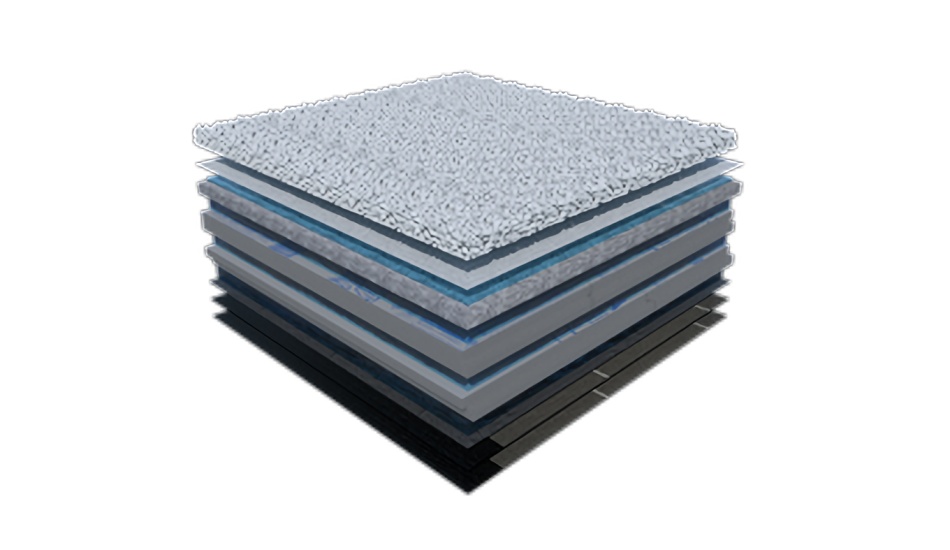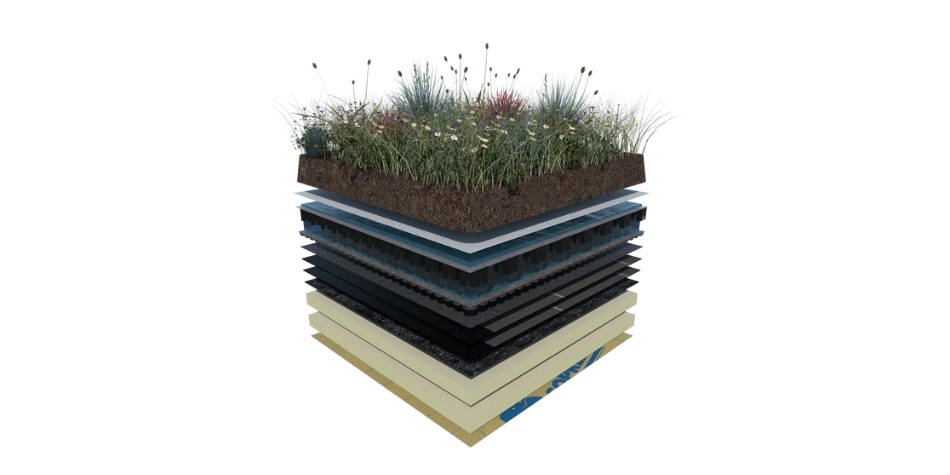The problems caused by the waterproofing of surfaces in our cities are no longer a mystery, let alone an isolated phenomenon.
Unfortunately, direct experience makes us realize the disasters that sudden and heavy rainfall can cause. City stormwater management infrastructures are often inadequate to manage the excess rain, and the work required to upgrade them demands staggering sums that municipalities generally cannot afford. We must therefore turn to alternative solutions that allow rapid implementation, and at a lower cost than these major municipal works. Vegetated infrastructures make this possible. Plants are indeed the best tool for managing rainwater and they bring a multitude of direct benefits to our daily lives: improvement of air quality, reduction of ambient temperature, improvement of biodiversity, creation of aesthetic and pleasant spaces … the list goes on.
We must act now and learn to manage water as a resource and not as waste. It is necessary to reduce the total volume of discharge and to regulate the flow by favouring the use of rainwater by plants.
We must act now and learn to manage water as a resource and not as waste. It is necessary to reduce the total volume of discharge and to regulate the flow by favouring the use of rainwater by plants. But how can we integrate these plants into our environment?
Green roofs may have this potential, but for many municipalities, they are not considered an effective method for managing water at the source. Why? A green roof, which acts like a sponge, has maximum storage capacity. Once it reaches its maximum saturation threshold, all excess rain is directed to the sewer drain as quickly as if there were no green roof at all. This is why a green roof must be combined with another solution to manage both the total volume and the discharge flow to the sewer. This is where blue and hybrid roofs come in!
First, we have to consider that cities are increasingly mineralized, which is a serious problem. Soil sealing automatically results in less runoff infiltration into groundwater and more runoff to sewer systems.
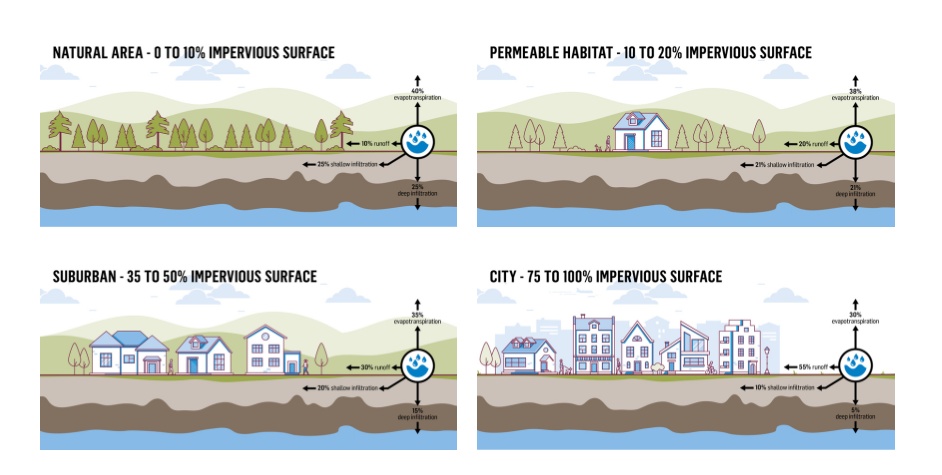
In addition to radically modifying the water cycle, the congestion of sewer networks increases the pollution of natural environments by causing floods, during which the combined sewer networks discharge wastewater directly into the rivers without treatment. This causes, in addition to flooding, the pollution of natural environments.

We cannot deny that a significant area of cities is made up of roofs. We can see this when we fly over them in an airplane. What do we see when we fly over cities? Mainly roofs. These large surfaces of building tops are greatly overlooked. Generally, they receive minimal maintenance and are used to install mechanical units. However, roofs are the first surface in contact with rainwater; hence the idea of managing rainwater at this precise location, without having to divert it entirely to a network designed for this purpose. This way, we could make rainwater useful in the city. What a simple and ingenious idea! But how can we make it happen?
Simply by turning nature-based concepts into action. In stormwater management, the use of plants plays a significant role. In addition to promoting biodiversity and cooling the cities, nature-based solutions can help create a more comfortable environment and save money in the long run. However, these solutions must comply with municipal stormwater regulations.
In recent years, various municipalities, such as Montréal, Toronto, Québec City, Victoriaville and Vancouver have followed suit and adopted strategies to promote sound stormwater management on their territory. These regulations are put in place in several ways and can act as legislative regulations or even take the form of a guide to best practices. It is interesting to note that the City of Toronto, one of the first cities in Canada to adopt a policy requiring green roofs, did so mainly for the sake of effective stormwater management. It is also encouraging that these regulations generally concern not only the quantity, but also the quality of the discharged water.
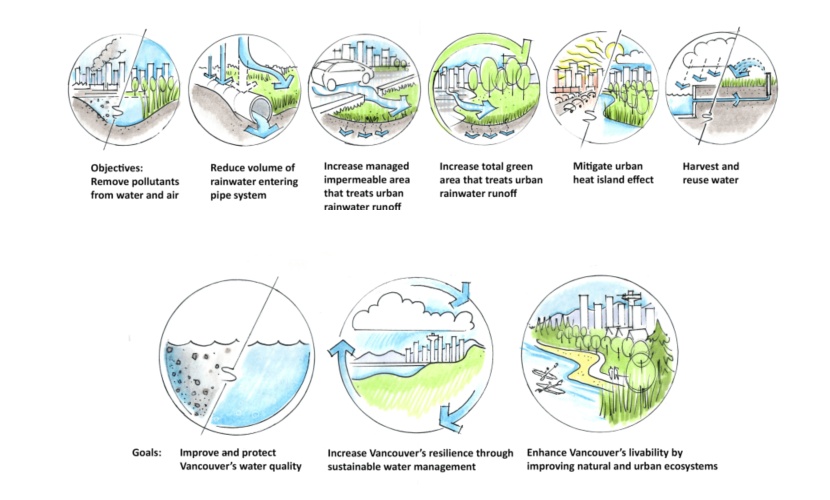
Source: https://vancouver.ca/files/cov/rain-city-strategy.pdf
The climatic contexts of the various cities all over the Canadian territory require that these municipalities adapt their regulations to these climates.
There are indeed several types of rainfall. The regulations aim at mitigating the effects of common rainfall, while for intense (extreme) rain events, the objective is to protect people and infrastructure as well as managing temporary flooding in order to limit environmental and human disasters.
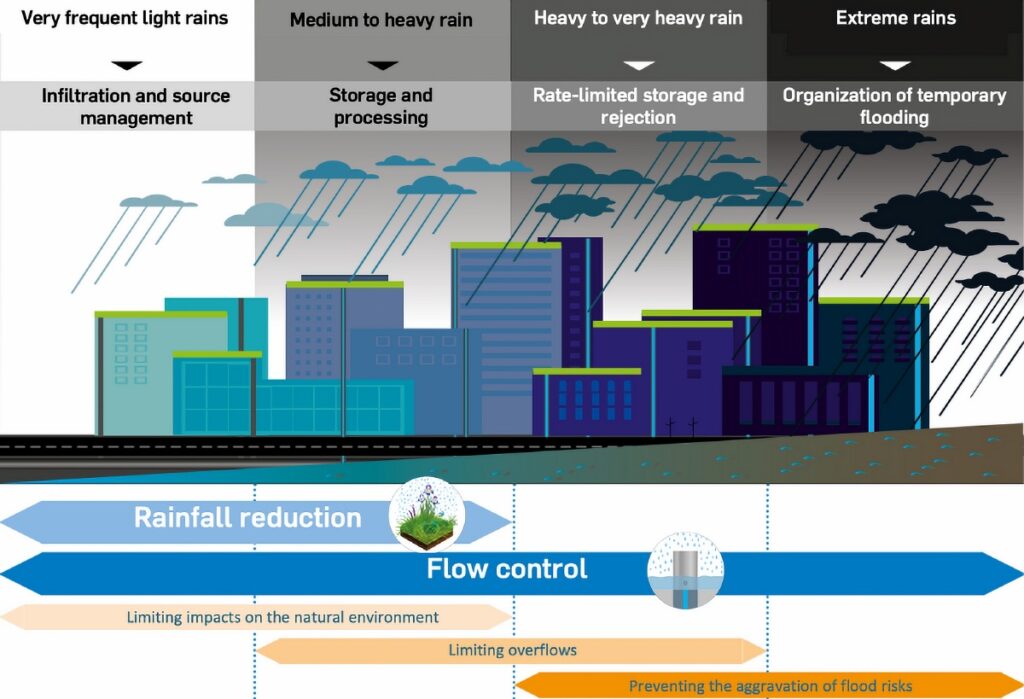
There are two ways to limit this damage, namely the two fundamentals of urban stormwater management: rainfall retention and flow reduction.

Rainfall Retention
Rainfall retention is the capture in whole or in part of rainwater on the surface where it falls. This water is therefore managed on the roof and is not sent to the sewers. These solutions are essentially based on nature and use plants to ensure rainfall retention. By storing water into the green roof, the plants draw on this resource, and through the phenomenon of evapotranspiration, return it to the water cycle. In addition, these plants, through evapotranspiration, help cool the ambient air.
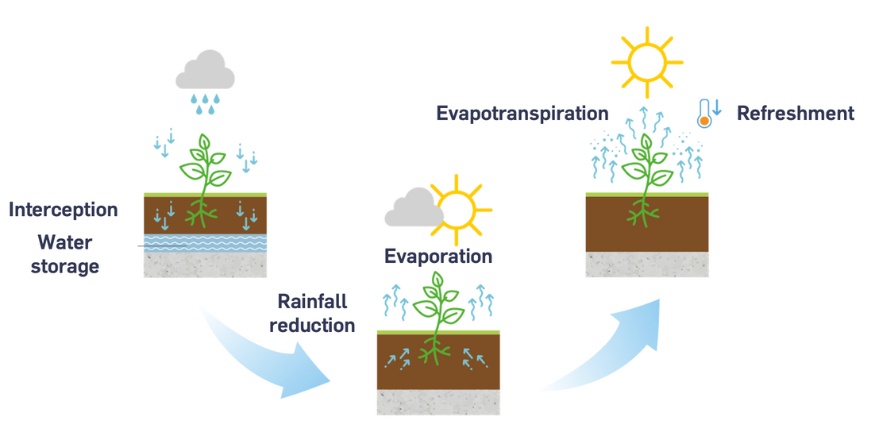
Buildings, roads and urban infrastructure, in addition to waterproofing surfaces, store heat throughout the day and release it at night, preventing the ambient air from cooling. Quite the opposite of the natural effect of plants! It is, of course, the multiplication of vegetated surfaces that can have a significant impact on the temperature of a city.
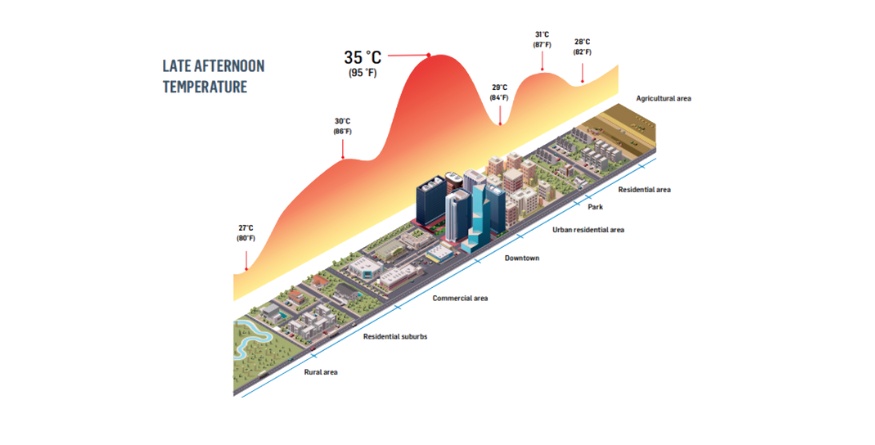
All green roofs contribute to rainfall retention and the reduction of volume to the sewer. The thickness of the substrate has a significant impact on the total volume retained—more substrate, more retention! We should therefore size the green roof according to the targeted performance. Depending on the system, it is possible to reduce almost 100% of the runoff from common rains. Of course, the area covered by the green roof must be taken into account and not just the total volume of substrate. For example, a green roof of 10 m2 with a thickness of 1 m of substrate will not have as great an impact on the reduction of the volume of water retained as a roof of 100 m2 with 100 mm of substrate. It should be noted that an extensive green roof with 100 mm of substrate will be able to capture approximately 60% of the rainfall.
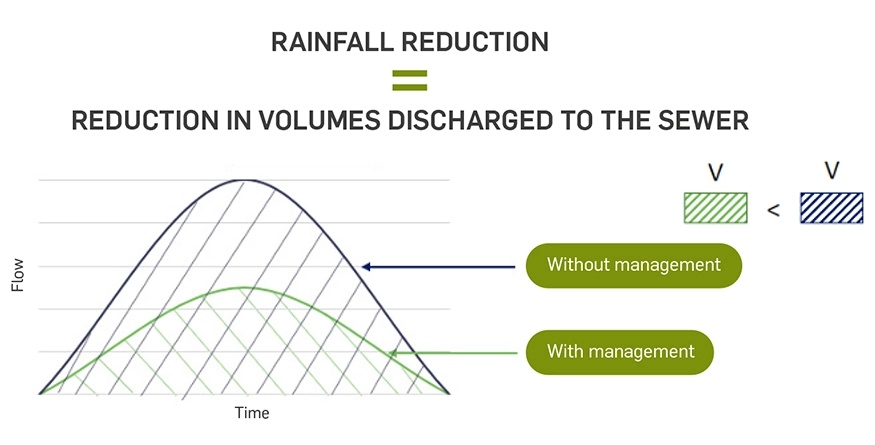
Regulate Discharge Flow
With flow reduction solutions, the total volume of water is not affected over time. It is about delaying the evacuation of runoff water towards the networks through temporary detention. This way, we can minimize the harmful effects of very intense rain episodes, commonly called “rain peaks”, and avoid the congestion of sewer networks and the saturation of treatment plants.
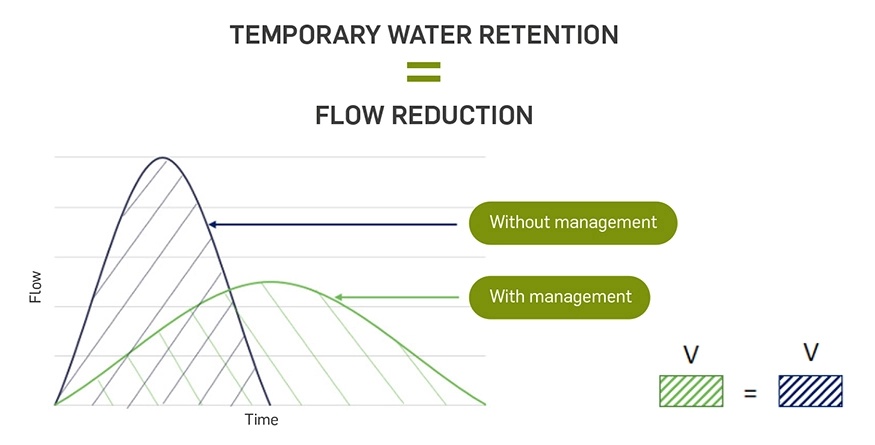
The main problem for municipalities is the management of these same peak flows in the event of heavy rains which temporarily overload the sewer networks and create floods and overflows. This is what we are trying to mitigate with the regulation on the roof thanks to blue roofs. Blue roofs are a solution that allows rainwater to be retained on the roof and gently redirected to the sewers within 24 hours after the event. Blue roofs are an effective method of reducing the load on the municipal water system and preventing the risk of flooding.
SKYWATER – Ballasted Blue Inverted Roof
A Powerful Combo
To both reduce the total volume and regulate the rejection rate, we must instead turn to hybrid solutions. Hybrid roofs combine the benefits of green roofs and blue roofs at the same time. This combination is considered the most effective, as it allows water to be retained both in the substrate and in the storage units below it. This option provides maximum capacity for water capture and management at the source. Therefore, it allows us to optimize the performance of the two systems by combining them.
SKYWATER – SOPRAFLOW CONTROL Hybrid Roof
The importance of better stormwater management is increasingly being recognized by our institutions. Now is the time to take action and reinvent the way we design buildings.
~ Roxanne Miller
 Roxanne Miller is a certified Landscape Architect and long-term Green Roof Specialist. Throughout her extensive career, she has worked on design, installation, maintenance and research on green infrastructures of all kinds and scopes. She has had the opportunity to collaborate on projects all over the world and uses that experience to further her own knowledge and provide educational material and services.
Roxanne Miller is a certified Landscape Architect and long-term Green Roof Specialist. Throughout her extensive career, she has worked on design, installation, maintenance and research on green infrastructures of all kinds and scopes. She has had the opportunity to collaborate on projects all over the world and uses that experience to further her own knowledge and provide educational material and services.
SOPREMA has developed a range of solutions for the sound management of stormwater on the roof.
Within the SOPREMA family, she acts as Business Development Manager for the SOPRANATURE line, which includes blue, green and solar roof solutions.
If you have any comments, please email romiller@soprema.ca.
 Greenroofs.comConnecting the Planet + Living Architecture
Greenroofs.comConnecting the Planet + Living Architecture


